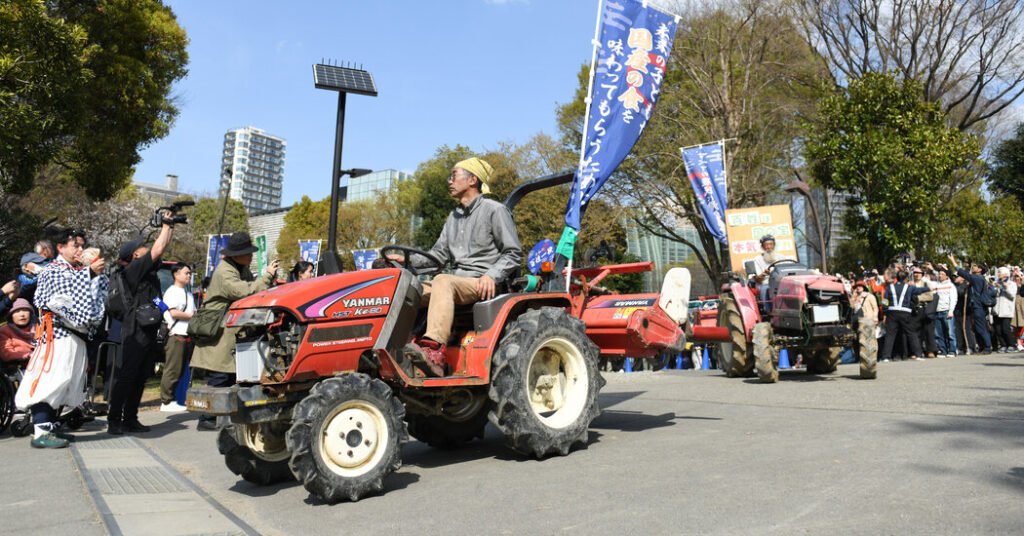In the USA, the affordability of eggs has prompted a nationwide dialogue — underscoring anxieties in regards to the economic system and the federal government’s position in addressing them. In Japan, there’s an equal: rice.
Over the previous yr, Japan has grappled with a greater than 200,000-ton scarcity of its staple grain. Rice costs have skyrocketed, and supermarkets have been compelled to limit quantities that customers can purchase. The scenario grew to become so dire that the federal government needed to faucet its emergency rice reserves.
The twist is that at the same time as Japan offers with shortages, the federal government is paying farmers to restrict how a lot they develop. The coverage, in place for greater than half a century, consumes billions of {dollars} a yr in public spending.
Farmers exasperated with the federal government rules protested on Sunday. Beneath cherry blossoms in a park in central Tokyo, greater than 4,000 farmers, carrying straw hats and solar caps, gathered with indicators declaring “Rice is life” and “We make rice however can’t make a dwelling.” Thirty of them drove tractors by means of the skyscraper-lined streets of the capital metropolis.
The power of Japan to handle its rice downside might have important implications for the nation’s political and financial panorama within the months forward.
Final month, recent meals inflation surged 19 %, pushed by an 81 % rise within the worth of rice. Anxieties over the price of meals and different staples have weighed on Japanese customers, and the economic system, as households reduce on spending.
Shortages of Japan’s staple meals are additionally occurring earlier than an higher home election — anticipated in July — that would be the first nationwide ballot for the prime minister, Shigeru Ishiba. His predecessor resigned final August, going through dismal public approval rankings brought on largely by the price of primary items.
The rice shortages stem from a mixture of components, together with document summer time warmth in 2023 that broken the harvest and a surge in tourism that has led to elevated rice consumption.
However specialists say the basis trigger lies in a decades-old coverage that has systematically diminished arable land for rice rising. For the reason that Seventies, Japan has backed farmers to curtail the manufacturing of rice. The aim, officers say, is to assist farmer incomes by sustaining excessive costs.
Farmers on the protest on Sunday stated that coverage isn’t working.
In 2022, the typical earnings of rice farmers was round $23,000, in line with statistics from Japan’s agriculture ministry. That stage of earnings hasn’t been sufficient to draw younger farmers, leaving the trade quickly growing old and shrinking by tens of hundreds of staff annually.
“If issues proceed on this means, our farms will disappear. The merchandise that we produce will disappear,” stated Yoshihide Kanno, 75, a rice farmer from a prefecture north of Tokyo, and one of many leaders of the demonstration. “Earlier than that occurs, we have to change Japan’s misguided agriculture insurance policies.”
Over the previous 5 a long time, Mr. Kanno stated, a couple of third of the rice paddies in his city have been deserted. “Why do we now have to scale back manufacturing when there are shortages and fields obtainable?” Mr. Kanno requested. “If my son and grandchildren are to proceed farming, there must be a longer-term outlook.”
Japan has continued to stick to a coverage of limiting rice manufacturing to maintain costs excessive, in distinction with the USA and the European Union, which have as an alternative adopted methods that permit farmers to supply as a lot as they need whereas subsidizing them for price-related losses.
Adopting an analogous coverage in Japan would value the federal government about $2.65 billion per yr, in contrast with the $2.32 billion at the moment being spent on encouraging farmers to chop manufacturing, in line with calculations by Nobuhiro Suzuki, a professor on the College of Tokyo specializing in agricultural economics.
Whereas barely extra pricey, a coverage centered on increasing manufacturing would improve rice provide, enhancing Japan’s meals safety, whereas decreasing costs for customers, Mr. Suzuki stated. Enabling farmers to develop with out restrictions whereas backstopping their incomes would additionally make the trade extra enticing to new generations of staff, he stated.
There are lots of theories why rice production-reduction insurance policies have prevailed. Mr. Suzuki suggests it stems from a broader austerity development throughout the Japanese authorities, making it difficult to justify even marginal will increase in agricultural spending. Others suggest that some stage of pork-barrel politics could also be an element.
A spokesman for Japan’s agriculture ministry stated that, “like with the rest,” the federal government promotes producing a stage of rice that aligns with demand projections.
Traditionally, debates in Japan over agricultural coverage have spurred political shifts. In 2007, a key issue within the transient ouster of the Liberal Democratic Social gathering — which has held energy virtually constantly since its founding in 1955 — was the opposition social gathering’s advocacy for taking away insurance policies decreasing rice manufacturing.
For now, what is evident is that till agricultural coverage undergoes basic reform, the issue of rice shortages will persist, stated Mr. Suzuki, the professor on the College of Tokyo. Meaning, he stated, heading into the summer time elections, “the anger of farmers and residents will proceed to rise.”
